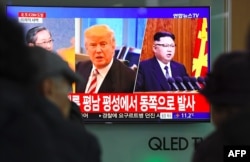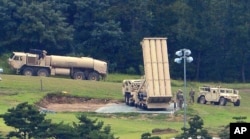As the United States and South Korean air forces on Monday launched their largest ever joint drills, questions are being raised whether North Korea’s missile test has shown it has already crossed what Seoul deems a “red line” – having a nuclear-tipped intercontinental ballistic missile –and what can be done about it.
The five-day annual Vigilant ACE military exercises this year involve more than 230 warplanes and 12,000 U.S. military personnel joining with South Korean troops.
While such large-scale joint exercises are routine, and scheduled well in advance, the drills begin less than a week after Pyongyang successfully launched its most advanced ICBM and declared itself a nuclear weapons power, a status the U.S. has called unacceptable.
South Korea’s air force says the drills will include simulated attacks on mock North Korean nuclear and missile targets.
Red line
North Korea’s test of the Hwasong-15 missile last week showed ruler Kim Jong Un’s ICBM program is more advanced than many previously believed and already capable of hitting the continental U.S.
Pyongyang has claimed the missile is nuclear ready – a subject of debate among experts, most of whom argue it is months or even years from perfecting. But South Korea does not believe the assertion.
"The government does not accept the North's 'unilateral' claim to completing its nuclear program,” said South Korea’s Unification Ministry spokesman Baik Tae-hyun at a Monday briefing. “We are making efforts to resolve the North's nuclear issue peacefully with the international community."
Seoul says it has not verified that North Korea’s missile has capabilities such as re-entry, precise guidance to terminal phase, and warhead operation.
If Pyongyang demonstrates those advances, it would cross what President Moon Jae-in in July called a “red line” for possible U.S. military action – having a functional, nuclear-tipped ICBM.
Pyongyang might soon cross that line, if it hasn't already.
“It now appears that the Hwasong-15 can deliver a 1,000-kg payload to any point on the U.S. mainland. North Korea has almost certainly developed a nuclear warhead that weighs less than 700 kg, if not one considerably lighter,” wrote ballistic missile analyst for the U.S.-Korea Institute at SAIS’s 38 North program, Michael Elleman, shortly after the test.
Potential for war
U.S. officials have warned they will not allow Pyongyang to threaten the U.S. with a nuclear missile, raising the possibility that Washington could launch a preemptive attack on North Korea.
Pyongyang denounced this week’s drills as preparation for such an attack, as it always does, and warned the U.S. is driving the peninsula to the “brink of nuclear war,” according to North Korea’s state-run Korean Central News Agency.
But North Korea is not alone this time in warning that the two sides are getting closer to war.
White House national security adviser HR McMaster on Saturday said the chance of war with North Korea was “increasing every day.”
Republican Senator Lindsey Graham on Sunday called for the Pentagon to move U.S. military dependents out of South Korea because conflict with Pyongyang was getting closer to reality.
U.S. President Donald Trump has threatened to destroy North Korea if it attacks the U.S. or its allies. But it is not clear if Washington is ready for the heavy death-toll and destruction in South Korea - with half its population within Pyongyang’s artillery range – that would likely result from a preemptive attack to destroy North Korea’s nuclear and missile facilities.
“Red line responses don’t have to be military but they should be significant and painful politically and economically, if not militarily,” said Pacific Forum CSIS in Honolulu President Ralph Cossa. “They are also most effective if spelled out in advance and then acted upon.”
Hawaii on Friday tested nuclear alarm sirens not used since the end of the Cold War in the 1980s.
U.S. missile defense
Despite the warnings of war, and the Hwasong-15’s demonstrated reach, the Pentagon has said North Korea is not yet a threat to the continental U.S.
U.S. missile defense includes the Terminal High Altitude Area Defense (THAAD), also used in South Korea and Guam, the Ground-based Midcourse Defense (GMD) in Alaska and California, Patriot missiles in Japan, and the U.S. navy’s ship-based Aegis system.
U.S. missile defense has a checkered test record, successfully intercepting a mock warhead about half the time, noted 38 North's Elleman.
“If five missiles are fired, and the US responds with four interceptors per NK (North Korean) warhead, all five warheads would be destroyed about 80% of the time. In other words, the expectation would be that at least one warhead will evade the defenses 20% of the time.”
Peace in our time?
With North Korea’s nuclear missile program advancing much faster than expected, time is running out to avert war, said HR McMaster on Sunday.
Multilateral diplomatic options haven't gained any traction with Pyongyang since it refused nuclear inspectors in 2008 and withdrew from a deal on ending its nuclear programs made with China, Japan, Russia, South Korea, and the United States.
“I think diplomatic policy or six-party talks are over and North Korea is focusing on whether it can have negotiations with the U.S. or not, and it does not consider six-party talks at all,” said head of the World Institute of North Korean Studies Ahn Chan-il. “It's because the (purpose) of the six-party talks is to stop the operation of North Korea's nuclear program. So, even if the six countries gather and talk, they cannot reach anything as North Korea has almost become a nuclear power state.”
“I suspect we will just see more and more sanctions,” said Pacific Forum president Cossa. “The U.S. seems to be warning that it will seek ship inspections and more intrusive maritime measures, but it’s unclear Beijing and Moscow will go along.”
More optimistic analysis has suggested North Korea’s declaration of having “completed” its nuclear ambition may signal Pyongyang will turn towards its decrepit economy and away from further nuclear provocation.
“In order to reach both nuclear and economic development, it requires a huge budget, technology, labor, and resources,” said Ahn. “But the pressure and sanctions of the United Nations are reaching their highest and it is remote to prepare such conditions to realize Kim Jong Un's hope.”
North Korea experts will be watching Kim’s annual New Year's Day speech closely for any clues on how much closer Pyongyang intends to push the red line between peace and war.











